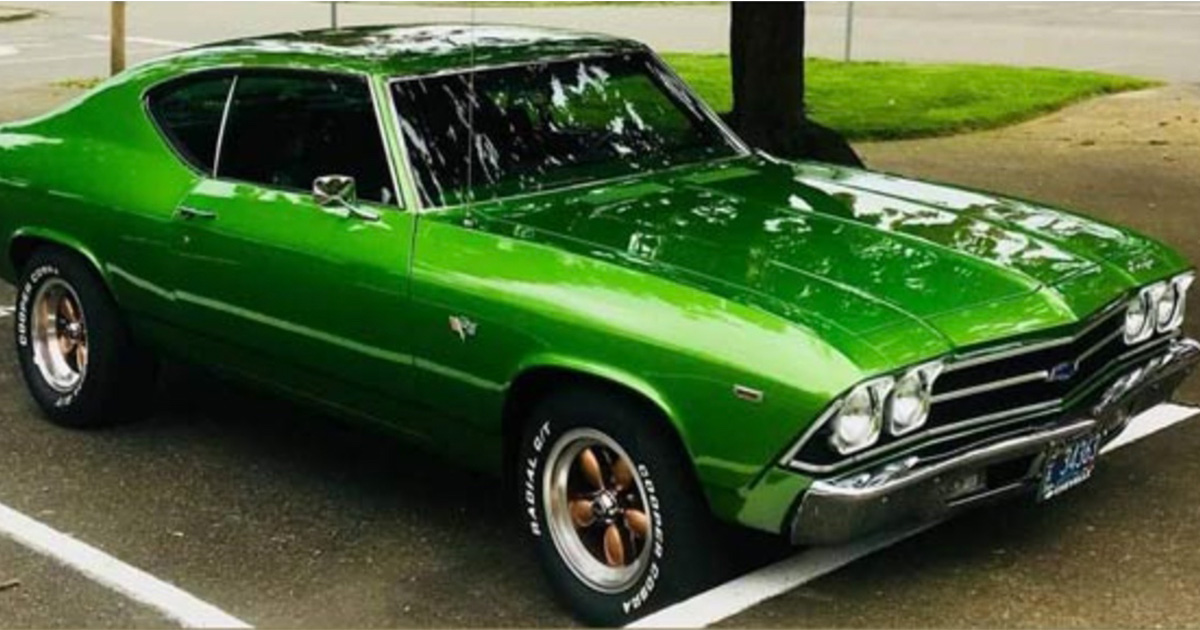Jaw Dropping Custom Built 69′ Chevrolet Chevelle

Just as the muscle car movement edged closer to its yet-unseen climax, Chevrolet went and did something the competition wasn’t doing: It demoted its performance Chevelle from a separate model to an option package for 1969. It seemed like an odd move: Buyers were flocking to dealerships flush with cash, or backed by credit, looking for a supercar to sweep through Main Street by simply checking a box and signing papers. Such models were quick sales with little effort.
In this video, I give a full tour of a Custom 1969 Chevrolet Chevelle showing the exterior, engine, and interior. (468 Big Block, Gear Vendor Overdrive, Turbo 350 Transmission, Baer Brakes)
About the Second generation (1968–1972)
The 1968 Chevelle received an all-new distinctly sculpted body with tapered front fenders and a rounded beltline. The car adopted a long-hood/short-deck profile with a high rear-quarter “kick-up”. While all 1967 Chevelle models rode a 115-inch (2,900 mm) wheelbase, the 1968 coupes and convertibles now rode a 112-inch (2,800 mm) wheelbase. The 4 door sedans and wagons turned to a 116-inch (2,900 mm) span. Tread width grew an inch front and rear. Hardtop coupes featured a semi-fastback, flowing roofline with a long hood and short deck, influenced by the all-new Camaro. The fastback appearance was a revival of a streamlining Bodystyle on all GM products from 1942 until 1950, as demonstrated on the Chevrolet Fleetline. Top-trim models (including the SS 396 and new luxury Concours) featured GM’s new Hide-A-Way wiper system. Lesser Chevelles would get that change later.
The entry-level Chevelle 300 (131 – 132 VIN prefix) was available as a pillared coupe and/or station wagon (Nomad) while the 300 Deluxe and Nomad Custom (133 or 134 VIN prefix) had a 2-door hardtop added to the lineup (fourth and fifth VIN characters will be 37; with the previous 300 Deluxe the hardtop was available with the Malibu and SS396 but not the base 300/Deluxe in the USA not counting those produced for the Canadian market). The Super Sport (SS396 sport coupe, convertible, and El Camino pickup) became a series on its own. Chevrolet produced 60,499 SS 396 sport coupes, 2,286 convertibles, and 5,190 El Caminos; 1968 was the only year the El Camino body style would get its own SS396 series designation (13880).
Government-mandated side marker lighting was incorporated, with early 1968 SS 396 light bezels seen with the SS 396 nomenclature – at some point in the later production cycle the engine callout had a 396 also shared with the Chevy II Nova SS (the side marker bezels, also sourced from the Chevy II Nova in 307, 327, and 396 displacements) had the engine displacement except for the six-cylinder models). Black-accented Super Sports had F70x14 red-stripe tires and a standard 325-horsepower 396-cubic-inch Turbo-Jet V8 engine with the special twin-domed hood; 350 and 375-horsepower 396 engines were optional. The SS 396 sport coupe started at $2,899 – or $236 more than a comparable Malibu with its 307-cubic-inch V8. All-vinyl bucket seats and a console were optional.
Three luxury Concours options became available in March 1968 the 4-door sedan, the 4-door sport sedan (and the hardtop coupe), and consisted of special sound insulation and a deep-padded instrument panel with simulated woodgrain accents and all-vinyl color-keyed interiors. Interiors were sourced and shared with select Buick, Oldsmobile, or Pontiac A body patterns – during the middle of the 1968 model year, some Chevrolet A-bodies (including the El Camino) ended up with interior door panels shared with the Buick or Oldsmobile A bodies (Special, Skylark) where supply and demand issues forced a substitution, and during the April 1968 production month in the wake of the assassination of Reverend Dr. Martin Luther King Jr. there were some work stoppages e.g. strikes. A ribbed stainless steel panel was bolted to the rear taillight panel and a ‘Concours By Chevrolet’ emblem on the rear decklid. Other options included power windows and door locks. With the hardtop, a rare option is a horseshoe floor shifter with an integrated console (with bucket seats – sourced from the SS).
These Concours options (ZK5, ZK6, and ZK7) should not be confused with the two Concours station wagons. At the time the ZK5, ZK6, and ZK7 Concours package was the equivalent of the Caprice. Also new for 1968 was the elimination of the term “sedan” for the 2-door pillar body style. This was now called a coupe (or pillar coupe) while the 2-door hardtop remained a sports coupe. These coupe/sport coupe designations would continue into 1969 as well. The Concours Estate Wagon was one of four distinct Chevelle wagon models. A one-year Nomad, Nomad Custom was offered.
Regular Chevelle engines started with a 140 hp (100 kW) Turbo-Thrift six or the new 200 hp (150 kW) Turbo-Fire 307 V8, and a 325 hp (242 kW) version of the 327-cubic-inch V8. Manual transmission cars got GM’s “Air Injection Reactor (A.I.R)” smog pump. New Federal safety-mandated equipment included side marker lights, as well as shoulder belts for outboard front seat occupants on cars built after December 1, 1967 – Via Wiki
top Test Drive 1969 Chevy Chevelle Big Block

